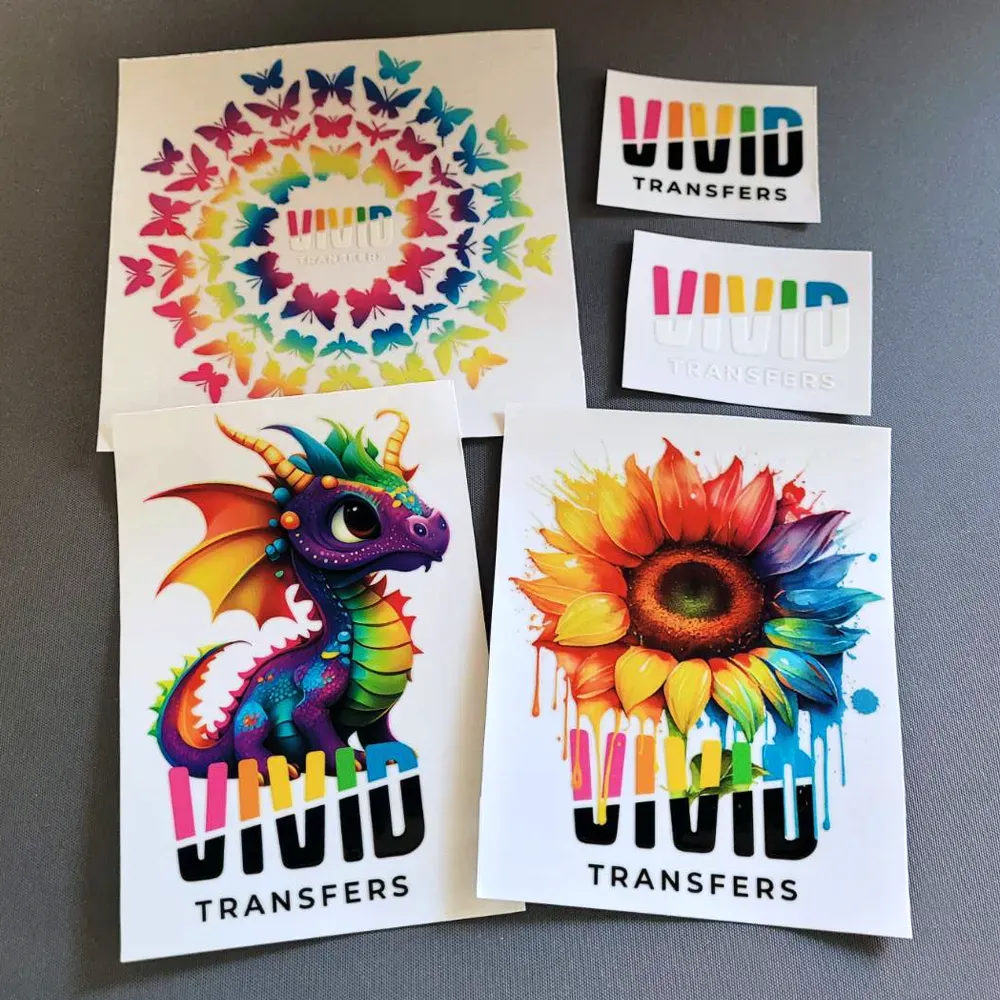In the rapidly evolving world of textile printing, **UV DTF transfers** represent a significant leap forward, harnessing cutting-edge technology to redefine traditional methodologies. This innovative approach combines ultraviolet (UV) curing with Direct to Film (DTF) printing, allowing for quicker, high-quality print applications on a variety of materials. Emphasizing eco-friendly printing, UV DTF technology not only enhances productivity but also aligns with sustainable printing solutions, addressing growing environmental concerns. As digital printing technology advances, UV DTF stands out for its ability to produce vibrant designs while minimizing waste and VOC emissions. In this blog, we will delve into the advantages of UV DTF transfers, exploring their impact on both manufacturers and consumers alike in the textile printing industry.
Also referred to as ultraviolet direct-to-film transfers, UV DTF technology combines the principles of modern printing with eco-conscious innovations to set new benchmarks in the industry. This approach utilizes a special UV curing process that instantly solidifies inks, making it a game-changer in textile and multi-surface applications. By integrating advanced printing technology with sustainable methodologies, UV DTF offers a versatile solution for graphic designers and manufacturers seeking both quality and efficiency. As an alternative to conventional textile printing methods, UV DTF introduces cost-effective workflows that can cater to the increasing demand for personalized and vibrant products. The convergence of eco-friendly practices with state-of-the-art digital printing techniques positions UV DTF as a frontrunner in the future of printing solutions.
Understanding the Innovation Behind UV DTF Transfers
UV DTF transfers represent a cutting-edge approach in the textile printing sector, leveraging advanced digital printing technology. Unlike traditional textile printing methods that rely on multiple steps, UV DTF printing streamlines the process by directly applying ink onto a specially coated film, followed by curing it with UV light. This not only expedites production times but also enhances print durability and color vibrancy, making it an attractive option for textile businesses looking to innovate.
In the context of technological advancements in printing technology, UV DTF transfers offer unparalleled potential. The immediate curing of inks allows for intricate designs that retain clarity and depth, which are often lost in other methods such as screen printing. This fermentation of innovation within the textile printing landscape marks a significant shift towards more efficient and effective printing processes.
Eco-Friendly Printing Solutions with UV DTF
As sustainability becomes a central theme in manufacturing, UV DTF transfers emerge as an eco-friendly printing solution. The process generates fewer volatile organic compounds (VOCs) due to its quick curing mechanism, aligning with the growing demand for sustainable practices in textile production. This reduction not only benefits the environment but also minimizes health risks for workers involved in the printing process.
Additionally, many UV DTF methods utilize water-based inks, which further diminish environmental impact compared to solvent-based inks traditionally used in textile printing. By opting for UV DTF technology, businesses can convey their commitment to sustainable printing solutions, ultimately appealing to an increasingly eco-conscious consumer base.
Versatility Across A Range of Materials
One of the standout features of UV DTF transfers is their remarkable versatility. This printing technique can be applied not just to textiles, but also to an array of surfaces like leather, wood, and plastic. Such capability allows businesses to expand their product offerings and cater to diverse markets, creating opportunities to reach a wider audience and enhance profitability.
Furthermore, UV DTF’s compatibility with various substrates eliminates the need for costly and time-consuming processes associated with preparing surfaces, such as printing on white bases for dark materials. This operational efficiency not only streamlines production but also allows for greater creativity and flexibility in design, which is a crucial factor in today’s competitive marketplace.
Maximizing Efficiency with UV DTF Technology
UV DTF printing significantly boosts production efficiency through its fast curing times. Traditional textile printing methods can entail lengthy drying periods which hamper manufacturing speeds. In contrast, the UV curing process allows products to be printed and ready for shipping in mere seconds, enabling businesses to ramp up their throughput and meet customer demand swiftly.
This enhanced efficiency is vital for textile manufacturers as it allows them to operate on tighter deadlines without sacrificing quality. With the advancements in printing technology, strategies that prioritize speed without compromising design become invaluable. This technological innovation positions UV DTF as a frontrunner in changing how businesses approach textile printing.
Navigating the Challenges of UV DTF Implementation
While adopting UV DTF transfers comes with numerous advantages, businesses must also navigate certain challenges. The initial investment for UV DTF printing systems can be substantial, encompassing not only the cost of the equipment but also the necessary training for staff to operate new systems effectively. This financial consideration is crucial for companies looking to integrate this advanced technology into their operations.
Moreover, ongoing maintenance of UV DTF printers is paramount to ensure consistent performance and adherence to evolving industry standards. As technology progresses, businesses need to factor in additional costs related to servicing and updating their printing systems, thus maintaining a balance between upfront costs and long-term operational efficiency.
The Future of UV DTF Transfers in Textile Printing
Looking ahead, the potential growth for UV DTF printing within the textile industry appears promising. Market research indicates that demand for digital printing solutions continues to rise, positioning UV DTF as a critical player in this evolution. With a focus on innovation, businesses that adopt this technology will not only meet contemporary printing needs but also pave the way toward future advancements.
As consumer preferences shift towards quality and sustainability, UV DTF technology stands ready to fulfill these demands. By leveraging modern printing technology advancements, businesses can not only meet current market trends but also build a reputation for innovation and responsibility in textile manufacturing.
Frequently Asked Questions
What are the key advantages of using UV DTF transfers in textile printing?
UV DTF transfers offer numerous advantages, including rapid curing times that significantly enhance production efficiency, high-quality print outputs with vibrant colors, and reduced environmental impact through fewer volatile organic compounds (VOCs). This technology allows for versatile applications across different materials, making it an excellent choice for modern textile printing.
How do UV DTF transfers compare to traditional textile printing methods?
Unlike traditional textile printing methods that often require long drying times, UV DTF transfers utilize ultraviolet technology to cure inks almost instantly. This results in improved production timelines and the ability to produce detailed, high-resolution images. Additionally, UV DTF transfers are more versatile, allowing printing on various substrates, including textiles, leather, and plastic.
Are UV DTF transfers considered eco-friendly printing solutions?
Yes, UV DTF transfers are recognized as eco-friendly printing solutions due to their reduced emissions of volatile organic compounds (VOCs) and the use of water-based inks. These features align with the growing demand for sustainable printing practices in the textile industry, making UV DTF an attractive option for environmentally conscious businesses.
What industries can benefit from UV DTF transfer technology?
UV DTF transfer technology is beneficial for a wide range of industries including fashion, sportswear, promotional products, and even interior decor. Its versatility allows brands to leverage this digital printing technology for creating unique designs on various substrates, thus catering to diverse market needs.
What should businesses consider before transitioning to UV DTF printing?
Before making the switch to UV DTF printing technology, businesses should consider the initial investment required for new printing systems, as well as the ongoing maintenance and training needed for staff. This preparation ensures that companies can effectively implement and maximize the benefits of UV DTF transfers in their production processes.
How does UV DTF transfer technology enhance the quality of printed textiles?
UV DTF transfer technology enhances textile print quality through its ability to produce vibrant colors and intricate designs at high resolutions. The UV curing process solidifies inks quickly, preventing smudging and allowing for a greater range of detail and complexity in designs compared to traditional methods like screen printing.
| Key Features | Details |
|---|---|
| What are UV DTF Transfers? | Printing designs onto a special film that is cured using UV light, resulting in vibrant imagery that can be applied to various textiles. |
| Advantages of UV DTF Transfers | 1. Technological Innovation – rapid curing and high-quality output, improving production timelines. 2. Versatility – can print on multiple surfaces, removing the need for white base layers. 3. Eco-Friendly – reduces VOCs and utilizes water-based inks. 4. Market Growth – increasing demand for UV printing solutions. 5. Challenges – initial investment costs and maintenance are necessary considerations. |
| Future Outlook | UV DTF transfers are set to revolutionize the textile printing industry by providing efficiency, versatility, and sustainability. Manufacturer adaptation is crucial for gaining a competitive edge. |
Summary
UV DTF transfers are a transformative development in the world of textile printing, merging cutting-edge technology with dynamic and sustainable manufacturing practices. As industries increasingly pivot towards innovative solutions, UV DTF transfers offer unmatched efficiency, vibrant print quality, and the versatility needed to meet diverse consumer demands. This unique printing method is reshaping traditional approaches by allowing for high-resolution designs across various materials while also prioritizing eco-friendliness through reduced environmental impacts and water-based inks. Therefore, businesses looking to thrive in the future of textile printing should consider adopting UV DTF transfers, positioning themselves at the forefront of this evolving market.


